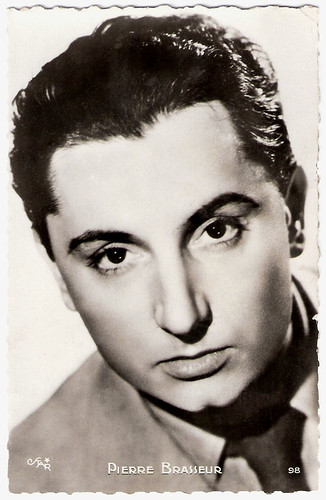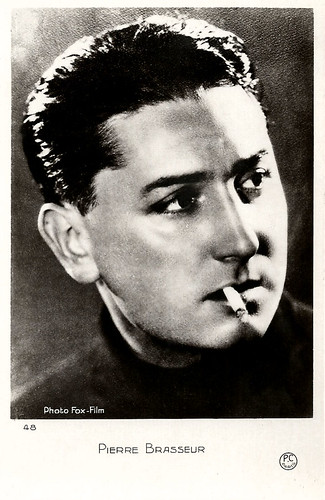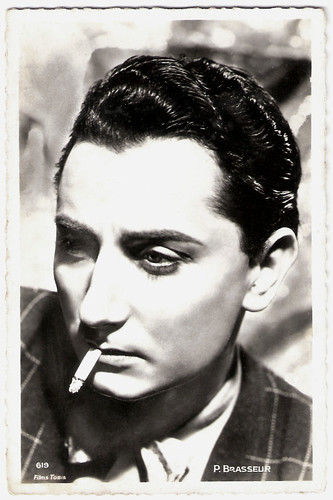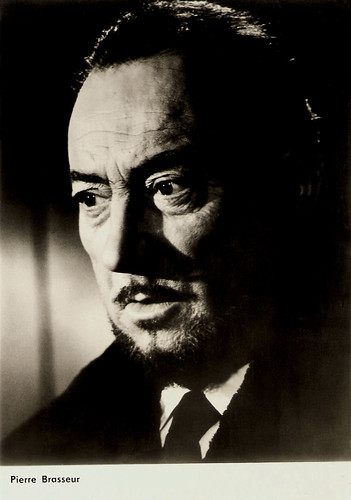
French postcard by Editions P.I., no. 98. Photo: Star.

French postcard by Editions du Globe, no. 125. Photo: Sam Lévin.
A kind of gigolo
Pierre Brasseur was born Pierre-Albert Espinasse in Paris in 1905. He was the son of actor Georges Espinasse and actress Germaine Brasseur while the latter was married to Albert Brasseur. His grandfather, Jules Brasseur, was an actor as well. Pierre failed the entrance exam at the Conservatory and followed acting classes from Harry Baur and Fernand Ledoux at the Conservatoire Maubel.
In 1920, he made his first stage appearance. In the 1920s, he mixed with the artists and poets of Montparnasse in Paris, where he developed a particular interest in surrealism. He started his film career in the silent cinema with small parts in productions like Jean Renoir’s film debut Une vie sans joie/Backbiters (Albert Dieudonné, Jean Renoir, 1924), and Madame Sans-Gêne (Léonce Perret, 1924) starring Gloria Swanson.
He had a bigger role in the war film Feu!/Fire! (Jacques de Baroncelli, 1927) starring Dolly Davis and Charles Vanel. That year, Brasseur performed the spoken role of the Narrator in the world premiere of Igor Stravinsky's opera-oratorio 'Oedipus Rex'. After the advent of sound, his film career accelerated. He first had a supporting part in the comedy Un trou dans le mur/A Hole in the Wall (René Barberis, 1930) with Jean Murat. This was the first film made at Joinville by Paramount Pictures.
Other early sound films were Mon ami Victor/My Friend Victor (André Berthomieu, 1931), Le vainqueur/The Winner (Hans Hinrich, Paul Martin, 1932) and Quick (André Daven, Robert Siodmak, 1932) with Lilian Harvey. These productions were alternative language versions of American or German pictures, and Brasseur starred in a dozen of these mostly run-of-the-mill productions, often as a kind of gigolo.
His other films of the 1930s include the comedy Un oiseau rare/A rare bird (Richard Pottier, 1935), the Colette adaptation Claudine à l'école/Claudine at School (Serge de Poligny, 1937) and most notably Le quai des brumes/Port of Shadows (Marcel Carné, 1938) starring Jean Gabin. In the meanwhile, he also played many stage roles and also wrote many plays himself, including 'L'Ancre noire' (1927, The black anchor), 'Un ange passe' (1943, An angel passes), and 'L'Enfant de Poméranie' (1945, The Child of Pomerania).

French postcard by PC Editions, Paris, no. 48. Photo: Fox-Film.

Belgian postcard by P.E. (Photo Editions), Brussels, no. 99. Photo: Studio Cayet. Jo Cayet (1907-1987) was a famous Brussels-based photographer.

French mini-poster (collector's card) by Pathé. Photo: CICC. Pierre Brasseur and Julien Carette in Sixième Étage (Maurice Cloche, 1941).
Children of Paradise
At the start of the Second World War, Pierre Brasseur returned to the stage and went on tour with his theatre company. In the cinema, he played a beautiful part as an alcoholic in Lumière d'été/Summer Light (Jean Grémillon, 1943), with Madeleine Renaud. His best-known role would be that of actor Frédérick Lemaître in the romantic drama Les Enfants du Paradis/Children of Paradise (Marcel Carné, 1945).
Hal Erickson at AllMovie: “Set in the Parisian theatrical world of the 1840s, Jacques Prévert's screenplay concerns four men in love with the mysterious Garance (Arletty). Each loves Garance in his own fashion, but only the intentions of sensitive mime-actor Deburau (Jean-Louis Barrault) are entirely honourable; as a result, it is he who suffers most, hurdling one obstacle after another in pursuit of an evidently unattainable goal.
In the stylised fashion of 19th-century French drama, many grand passions are spent during the film's totally absorbing 195 minutes. The film was produced under overwhelmingly difficult circumstances during the Nazi occupation of France, and many of the participants/creators were members of the Maquis, so the movie's existence itself is somewhat miraculous. Children of Paradise has gone on to become one of the great romantic classics of international cinema.”
After the war, Brasseur starred in Carné’s far less successful Les portes de la nuit/Gates of the Night (Marcel Carné, 1946). He also appeared in Les amants de Vérone/The Lovers of Verona (André Cayatte, 1949) starring Serge Reggiani and Anouk Aimée as actors in a film version of 'Romeo and Juliet'. Other highlights were the Jean-Paul Sartre adaptation Les mains sales/Dirty Hands (Fernand Rivers, Simone Berriau, 1951), and Le plaisir/The Pleasure (1952), three Guy de Maupassant stories directed by Max Ophüls.
His stage career remained equally distinguished. Jean-Paul Sartre wrote the title role in 'Kean' (1953), a biography of the famous English actor, expressly for Brasseur. He played an old drunkard in love with a beautiful young girl (Dany Carrel) in the prize-winning Porte des Lilas (René Clair, 1957). In the drama La Legge/The Law (Jules Dassin, 1959), he co-starred with Gina Lollobrigida.

French postcard by Ed. Chantal, Paris, no. 619. Photo: Films Tobis.

East-German postcard VEB Progress Filmvertrieb, Berlin, no. 2.623, 1966. Retail price: 0,20 MDN. Photo: publicity still for Les bonnes causes/Don't Tempt the Devil (Christian-Jaque, 1963).

French playing card. Photo: Sam Lévin.
Eyes without a face
Pierre Brasseur’s film career, began a new phase with La Tete contre les Murs/Head Against the Wall (Georges Franju, 1959), the first feature film directed by Georges Franju. The following year, he starred as the sinister Docteur Génessier in Franju’s classic Horror film Les Yeux sans visage/Eyes Without a Face (Georges Franju, 1960) with Alida Valli as his assistant.
James Travers at Films de France: “Criticism in the press ranged from enthusiastic approval to outright disgust. There is next to no explicit horror in the film (and certainly nothing like the gore offered by Hammer and Bava), yet the sequence in which Pierre Brasseur occupies himself with the removal of a human face from a living donor has become one of the most notorious in film history. Les Yeux sans visage differs from virtually all other films in the fantasy-horror genre. It doesn’t set out to shock us with gruesome images or insult our intelligence with an implausible plot or fantastic characters. Everything it shows us is frighteningly plausible, but presented to us in a dreamlike manner which, if anything, softens the horror of the situation.”
That year Brasseur also co-starred with Marcello Mastroianni and Claudia Cardinale in Il bell'Antonio/Bell’Antonio (Mauro Bolognini, 1960). He worked again with Franju at Pleins feux sur l'assassin/Spotlight on a Murderer (Georges Franju, 1961) with Pascale Audret. In 1966, he was made Chevalier (Knight) of the Légion d'honneur, and a year later Commandeur (Commander) of the Ordre des Arts et des Lettres in 1967.
He continued to work steadily and notable is his portrayal of a cruel dictator in Goto, l'île d'amour/Goto, Island of Love (Walerian Borowczyk, 1969) and his final feature La più bella serata della mia vita/The Most Wonderful Evening of My Life (Ettore Scola, 1972) with Alberto Sordi. That year his colourful memoirs were published: 'Ma Vie en Vrac' (My Life as a Whole).
In 1972, while shooting La più bella serata della mia vita, Pierre Brasseur died of a heart attack in Brunico (Bruneck), Italy. He was 66. Brasseur had been married twice. His wives were actress Odette Joyeux (1935-1945) and pianist Lina Magrini (1947-1961). Since 1967 his partner was actress and singer Catherine Sauvage. The family tradition of using the name Brasseur was continued by his son, actor Claude Brasseur and his grandson Alexandre Brasseur, who is a film actor as well.
Trailer Le quai des brumes/Port of Shadows (1938). Source: BFI Trailer (YouTube).

French postcard by Editions du Centre Pompidou and Flammarion, 1994 / Affiches Gaillard, Paris. Design by Jacques Bonnaud. Reproduction of the original poster for the film Les enfants du paradis. I. Le boulevard du crime (Marcel Carné, Pathé Consortium Cinéma, 1943-1945).
Trailer Les Yeux sans visage/Eyes Without a Face (1960). Source: La Chambre Verte (YouTube).
Sources: Hal Erickson (AllMovie), James Travers (Films de France), Encyclopaedia Britannica, Wikipedia (French and English) and IMDb.
This post was last updated on 30 July 2023.
No comments:
Post a Comment